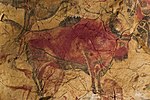Cave of Altamira and Paleolithic Cave Art of Northern Spain

The Cave of Altamira and Paleolithic Cave Art of Northern Spain (Cueva de Altamira y arte rupestre paleolítico del Norte de España) is a grouping of 18 caves of northern Spain, which together represent the apogee of Upper Paleolithic cave art in Europe between 35,000 and 11,000 years ago (Aurignacian, Gravettian, Solutrean, Magdalenian, Azilian). In 2008, they were collectively designated a World Heritage Site by UNESCO. Chief among these caves is Altamira, located within the town of Santillana del Mar in Cantabria. It remains one of the most important painting cycles of prehistory, originating in the Magdalenian and Solutrean periods of the Upper Paleolithic. This cave's artistic style represents the Franco-cantabrian school, characterized by the realism of its figural representation. Altamira Cave was declared a World Heritage Site in 1985. In 2008, the World Heritage Site was expanded to include 17 additional caves located in three autonomous communities of northern Spain: Asturias, Cantabria and the Basque Country.
Excerpt from the Wikipedia article Cave of Altamira and Paleolithic Cave Art of Northern Spain (License: CC BY-SA 3.0, Authors, Images).Cave of Altamira and Paleolithic Cave Art of Northern Spain
Acceso a las Cuevas de Altamira,
Geographical coordinates (GPS) Address Phone number Website Nearby Places Show on map
Geographical coordinates (GPS)
| Latitude | Longitude |
|---|---|
| N 43.3774 ° | E -4.1225 ° |
Address
Museo Nacional y Centro de Investigación de Altamira (Museo de Altamira)
Acceso a las Cuevas de Altamira
39330
Cantabria, Spain
Open on Google Maps








